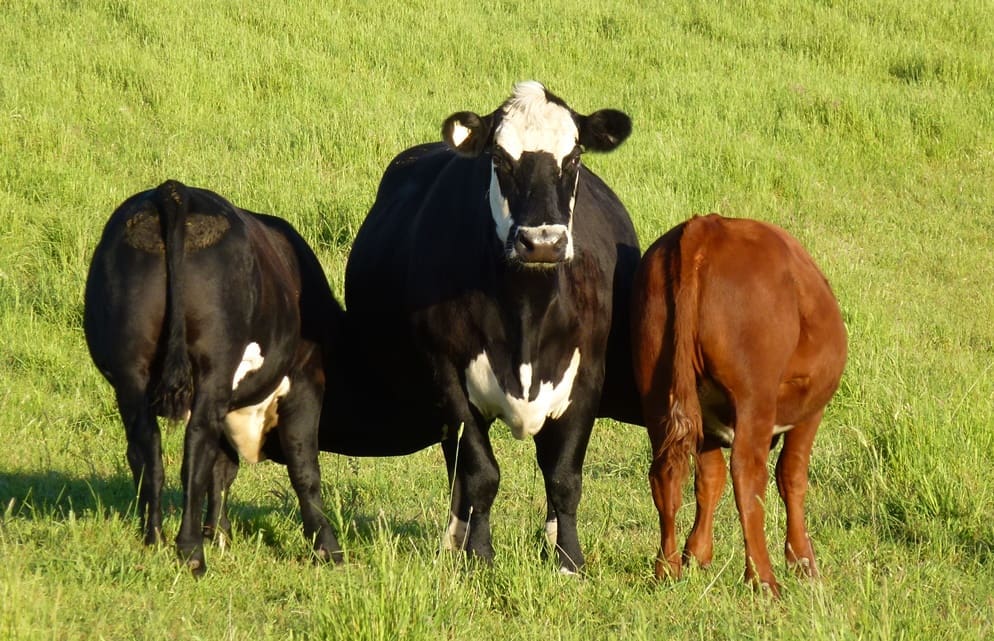
USMARC cow with twin calves on Leo Cummins property Admetus
DURING times like this when the national beef herd is recovering after drought, cattle producers look on with envy at the sheep industry, where rates of twinning are common – and contributing heavily to the pace of the rebuilding and restocking process.
But is it possible to select beef cattle for high rates of twinning?
A small but enthusiastic group of cattle producers in western Victoria have been exploring this topic for the past 16 years, with considerable success.
Retired Victorian research scientist Leo Cummins and his colleagues started selecting cattle for twinning performance in 2005.
Mr Cummins, who worked at the Pastoral and Veterinary Institute at Hamilton, led a study into twinning in both sheep and cattle during his professional life, and has retained his passion for the topic since his retirement in 2002. At one point he earned a Meat Research Corporation scholarship to move to Armidale to work with UNE and CSIRO animal scientists looking at twinning performance in Booroola sheep – regarded as the starting point in understanding ways to increase reproduction rates in sheep.
Former Beef CRC head Dr Bernie Bindon, well known to many Beef Central readers, was one of the main collaborators. Work focused on both understanding the physiology as well as the genetics behind the prolific- twinning Booroola sheep. The group discovered a major gene in the sheep that played a significant part in the process.
Encouraged somewhat by the results in the Booroola sheep project, a cattle twinning selection line was established at Armidale in the 1980s, based on various British breeds. The project advertised to purchase cows that had had twin calves, to establish the herd.
“In essence, they were mainly sheep researchers involved, but while they were keen, and interested in the cattle, the cattle were really a sideline,” Mr Cummins said.
Around the same time, the US Department of Agriculture got interested in twinning performance, establishing a breeding line called USMARC (US Animal Research Centre), based out of Clay Centre, Nebraska.
The USMARC herd – a single-purpose research selection line, based on about a dozen breeds – was selected for around 25 years at Clay Centre, rising over that time from a 2pc twinning rate to 160pc calving.
In the early 2000s, the project was concluded, and Mr Cummins was presented with the opportunity to import some USMARC genetics to Australia, via embryos and semen. His first calves hit the ground in 2004.
He estimates there are currently around 100 USMARC descendent cattle in Australia, including around 60 in his own herd on his property, Admetus, plus several smaller herds run by colleagues. The property name Admetus was derived from Greek mythology, where a king’s herd of cows all had twin calves after being touched by the god, Apollo.
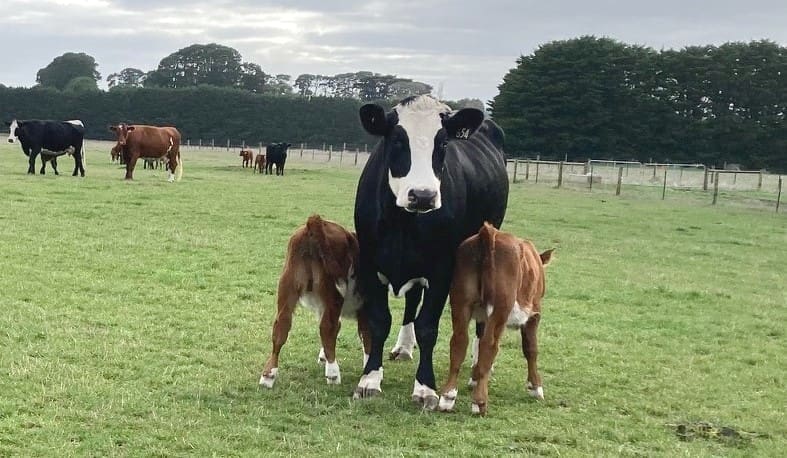
Cows with twin calves on Admetus
“Results have shown we can achieve very high twin conception rates with the USMARC cattle we have bred,” Mr Cummins said.
“But with higher rates of twinning comes its own issues. Calving must be managed quite carefully,” he said.
“They have very different reproductive capacity but they probably need more work to make people interested. It’s not the sort of stuff that can be done in large, less intensively managed herds, or in herds exposed to poorer nutrition.”
Mothering-up was another important factor after twin births.
Set out below is a summary of the March-to-May calving season performance recently completed at Admetus. The property regularly achieves 130pc calves born, and 120pc calves weaned each season. This would arguably be among the highest calving and weaning rates on any cattle property in Australia. In recent surveys, comparable Angus herds in the region average around 90pc weanings.
As the results below show, 53pc of mature cows on Admetus were sacanned for twins this year, and equally impressively, 33pc of first-calf heifers.
In comparison, the rate of twinning in conventional beef cattle varies from 2-4pc.
While rates of calf mortality in the herd may be relatively high, it is considerably less than lambs lost in high-twinning sheep flocks.
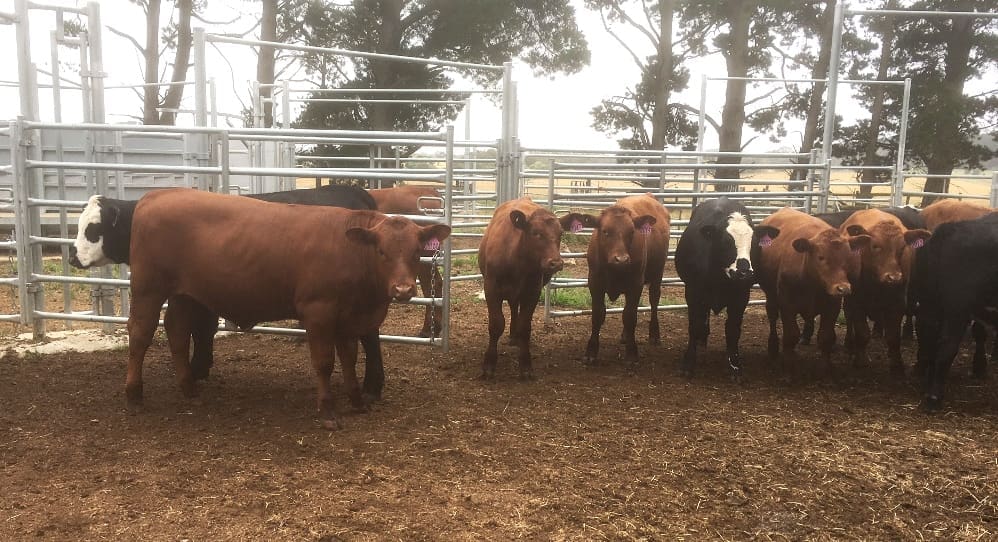
Weaners produced from Admetus herd with high rates of twinning preparing for sale
As the photos published here show, the USMARC descendent cattle in the Admetus herd are mixed colours, but predominantly reds and blacks (having obviously never been selected on coat colour.)
Phenotypically, they appear to be pretty good cattle, with reasonable bone and muscling. Weaners from the program are mostly sold in local store sales each year, and in terms of size and growth, achieve results comparable with other mainstream breeds.
Freemartins
Another factor universal with all sets of twin calves born to beef cattle is the fact that the majority of heifer calves born as mixed-sex twins are sterile (freemartins). It does not impact heifers born as same-sex twin heifers.
While the condition does reduce the number of heifers available to the herd as replacement breeders, the overall number of non-affected calves born – as either single calves, or heifer-heifer twins – offsets that. The net result is effectively the same number of potential heifer breeder replacements as a conventional herd.
GHG considerations
Another potential factor in finding greater acceptance for the twinner cattle is in considerations surrounding greenhouse gas emissions, Mr Cummins believes.
“This is not a surprise but a reflection of the fact that we can’t afford to carry non-productive stock, and more productive stock are better (both from a greenhouse gas point of view more obviously and importantly from a straight economic point of view).
2021 calving summary at Admetus
Calving at Admetus this year ran from 10 March to 1 May.
Grazing conditions through autumn were reasonably tight but the very wet winter (273mm rain through May June and July – 73mm above average) – made the late winter very tight, say 700-1000kg/ha food on offer in mid-July / August with moderate pasture pugging. It has been too wet to get out and do any supplementary feeding since mid-July. The cows were generally a little light but holding condition for the first half of winter but have lost weight in the second half.
Dr Ian McLeod did the pregnancy scanning on 19 August. The cattle were body condition scored at that time. The bulls are still with the herd so conceptions in the last 2-3 weeks will be recorded as not detectably pregnant. Therefore, potential end-date for calving is around 10 May 2022 (excluding any late conceptions).
Embryo transfer
Mating commenced with the embryo transfer program (Rob Pashen) on 5 June. Six carryover empty cows received one of Al joiner’s embryos. A backup bull went with them from 15 June. This was bull 912 till 8 July then bull 2019. Preg testing on 19 August revealed four cows pregnant to the ET and two to the backup bull. Therefore, ET calves due about 7 March 2022.
Artificial insemination
The 20 heifers were ovary-scanned on 24 May and 7 June then 16 of them were detected on heat and AI’d to Paringa Iron Ore on 9/10 June. (Cloprostenol was given to all on 24/5 and 7/6). One heifer not AI’d and not pregnant had no detected ovarian activity and a small uterus at scanning and was probably pre-pubic. The backup bull 2019 went with these heifers on 15 May and was replaced by 943 on 8 July. AI calves due about 19 March for singles and 12 March for twins.
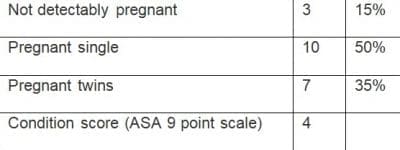
One heifer had calved 2 May (hard pull, dead at birth, seemed full term, therefore conception ~26 July 2020 at 4.5 months of age) and is excluded from these figures.
Natural mating
The bulls arrived from Cashmore on 15 June and were put straight out. The lactating cows and first-calf heifers were run together and were in two groups, that is, some in paddocks 1 & 2 and the rest in Paddocks 3 & 4. Bull 948 went into P1/2 and 943 went into P/4. Bull rotation occurred on 8 July.
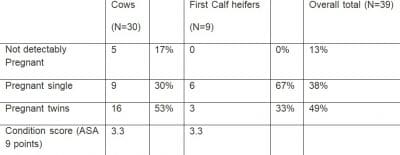
“Overall, I am fairly happy with these results,” Mr Cummins said. “The empty rate is a bit higher than I would hope for but most of the empty cows had had some problems (dystocia and/or getting thin and requiring drenching, however some of the pregnant cows had these issues as well).
“The twinning rate is good considering the nutrition was a bit marginal,” he said.
“At this stage we have 57 pregnant with 84 foetuses on board.”
- People interested in getting on board with the twin breeding project can contact Leo via Beef Central. Send an email to jon@beefcentral.com and we will pass it on.
